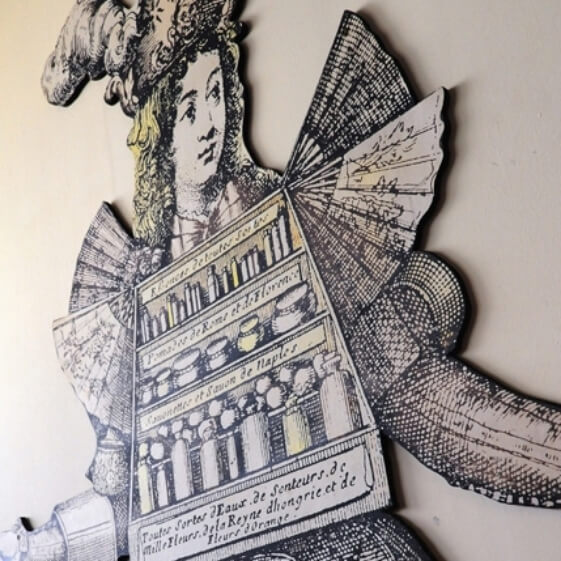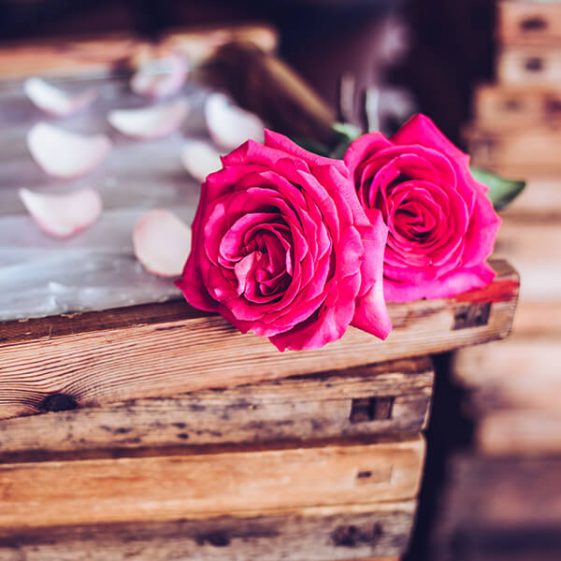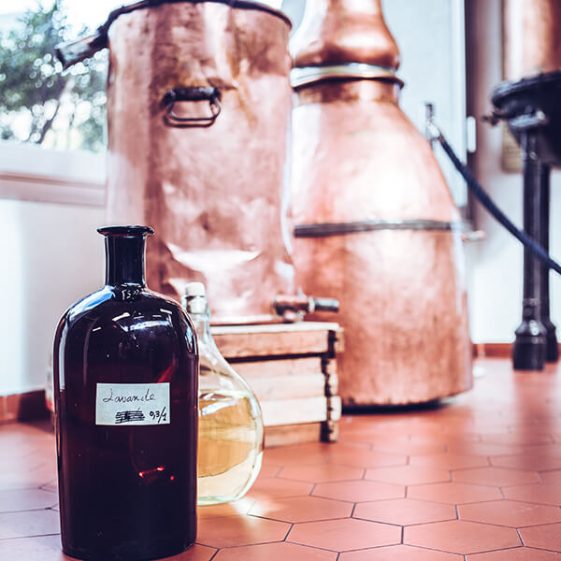Perfume in Grasse
Grasse is a city of 51.000 people, ideally situated between the sea and the mountains in that marvellous inland country of the « Côte d’Azur », only 17 kilometres from Cannes and 35 kilometres from Nice. In regard to its principal business, the French author Francis de Croisset, when speaking of Grasse, said that “Grasse is the only city in the world where the word factory (« usine ») is poetic.
It is not by chance that this city, an ancient commercial centre, became the cradle of the perfume industry. This region, in fact, has always benefited from ideal conditions for the production of flowers and their products: first, a very favourable climate with soft moderate temperatures, long periods of sunshine and short periods of rain; secondly, the earth is rich in alluviums resulting in very fertile soil; and, finally, the quality and character of the people who live here, who are at the same time very hard workers and endowed with a creative imagination.
In the early Renaissance the city was already a centre of the tanning industry and for the production of gloves (due in particular to the numerous flocks of sheep and at the same time the availability of spring water to treat the hides). Grasse also benefited in the Sixteenth Century from the fashion at that time of wearing perfumed gloves made popular by Catherine de Medicis. The city soon became famous at the court of King Louis XIII, so much so that in the year 1614 the corporation of Perfumed Glove-Makers was officially recognized.

The principal plants used at that time for making the perfume so used, were jasmine, rose and tuberose.
As the time passed the production of perfumed oils became more lucrative than the production of gloves which had declined in fashion and by the 18th Century there had arisen a substantial and significant industry, i.e. production of basic perfume essences or primary products.
It was not, however, until the beginning of the 20th Century that Grasse and its environs acquired a true international renown. This was due to the talents and savoir-faire of several great industrial families who had developed in the industry as it evolved. The factories so developed made possible the production of flowers, the importation of raw materials and the creation of essences and scented raw materials often made by their affiliates at the place of production.
Today, the industries in Grasse have increased and expanded their range of operation in response to the demands of an evolving market:
- First, the extension of perfume beyond the classic market (alcohol-based perfumes, cosmetics, soaps) to producers of detergents and washing soaps of great diversity in the cleaning and maintenance industry.
- Secondly, by the extraordinary development of production of food flavorings.
70 companies
Grasse currently hosts around 70 companies in the perfumery industry.
1,5 billion
A total gross revenue of over 1.5 billion euros (over 2.6 billion euros global consolidated turnover for companies with headquarters in France), of which 2/3 for perfumery and 1/3 for food flavourings.
5000 workers
These companies employ around 5000 workers and export 70% of their production.
The local production of flowers and the techniques
of extraction
The numerous visitors in the region search in vain for great fields of flowers. In fact, the cultivation of plants for perfume is concentrated in small family plots of land where the crop is seasonal and often of very short duration.
The rose (one particular variety called the « May rose ») is harvested from the first of May to the first of June, the flower of the orange tree from the end of April to the beginning of June and the jasmine in July and August.
The most spectacular fields to visit are those of the mimosa from January to March in the region of the « massif du Tanneron ». One can admire the flowers of broom in June and lavender in July.
The local plants used most are above all the jasmine, rose, the flowers and leaves of the orange tree, the tuberose, jonquil, violet, mimosa, lavandin and lavender.
Added to these are the materials imported from other countries in their raw and natural state :
- roots: like those of the iris of Tuscany, the vetyver from Haiti and/or Java, etc.
- lichens: such as oak moss from the Balkans
- seeds : ambrette from Martinique or the Seychelles, pepper, carrot, cumin or coriander seeds
- woods: sandal and cedar
- leaves: patchouli, geranium, violet
- bark: cinnamon, styrax
- gums: cistus, incense, opoponax
Extraction

1
Enfleurage – the extraction by solid dissolvents (fat)
This is the oldest method and almost forgotten and abandoned today. This avoids any alteration and enables one to capture the perfume of the most fragile flowers such as jasmine, tuberose or mimosa.
A mixture of animal fats is spread on a long table of glass. The petals of the flowers are strewn over this mixture and the process is repeated each two or three days. At the end of the season the fatty substances are dissolved to eliminate the vegetation wastes and then, by agitation in ethyl alcohol, the aroma is reduced to its concrete form of a pomade.
2
Distillation
This method produces the essential oils coming from plants in which they are contained in their natural vegetal state such as the lavender, patchouli, vetyver and geranium. This method cannot extract the aromas of the delicate flowers and their petals.
It is in the famous alembic that the distillation takes place. In the steam generator the created vapour carries the odor particles of the plant. This vaporous mixture is carried by the « swan’s neck » into the cooling area or « serpentin » where the vapour is reduced to its liquid state and it is in the « florentine vase » that the natural oils separate from the water by the simple difference in density.
For example, in order to obtain one kilogram of essence, 330 kilograms of the leaves of the patchouli or 150 kilograms of lavender must be distilled.

3
Expression
The basic oils of the hesperidees or of the citrus fruits (lemon, orange, bergamot or mandarin) may be derived from the use of heat and of appropriate chemical agents.
It should be noted that although most natural products used are vegetal in their base, there are four basic raw materials that come from animals, i.e.:
- amber (from the whale)
- musk (from the musk deer)
- castor (from the beaver), and
- civet (from the muskrat).
Nowadays these animal substances are reproduced synthetically.
4
Extraction by volatile solvents
This method works due to the low boiling point of certain solvents (ether, benzene, alcohol, acetone, etc…) which enables to obtain the base product from fresh vegetation and resins from dry vegetation.
The base product can then be reduced to its essence by the separation of residual waxes.
In this method, 600 kilograms of rose or jasmine are treated to obtain one kilogram of the absolute essence.
The perfumer
The perfume, obtained thanks to the fine blending of odorous substances is the culmination of the creative work of the perfumer.
Who is this mysterious person? What is his/her role? How does he/she work?
The perfumer or « nose » is a fragrance composer. In front of his/her working tool, his table called « organ », are found all the base products numbering at least 2.000 of which 1.000 are frequently used.
How is he able to recognize all of them, then to memorize their individual essences and finally to use them as he wishes?
It is thanks, first, to natural innate gifts:
- a good nose, olfactory acuity and a finesse of defined perception and sense of nuances and fragrances;
- an ability to concentrate with the capacity to isolate oneself from all external influences and to fix all attention on the odors;
- memory: first to learn each scent, to retain it, to fix in his/her sensual memory its characteristics and to be able to relate that scent to others already identified; finally the ability to recognize instantly from one odour, the products and the olfactory chords which he has also committed to his memory.
It is thus the working memory used again and again which is of great importance.
These naturals gifts must be maintained by strong self-discipline: protection of the sense of smell against any external negative influences (tobacco is one example); enhancement of the sensitivity by olfactory exercises, building of memory and continuous search of the utmost concentration.
One must also add to these natural gifts a certain form of character with desire and strength to rise above the obstacles which stand in the way of ultimate successful creativity:
- love of effort: what has been done must constantly be revised, for the olfactory world is fleeting;
- possession of a certain sensitivity derived from a fertile imagination and a sense of beauty: perfumes are forms, structures. The imagination conceives them and creates new forms which should be beautiful and pleasing. In order to be appreciated, perfumes must be the means of expression of the composer, whose distinguishing quality will be the sense of chords.
« One who masters scents, masters the heart of Humanity »
Patrick Süßkind
How does our composer develop his idea of a perfume?
This will happen often after smelling the odour of a new product whether it is a natural essence or a new original synthetic one.
His/her mind develops a series of ideas by association and will translate these ideas into the sensual structural form and from there to a formula, for the art of perfume is also that of finding the right proportions.
It must be noted that the perfume maker is not always right. Sometimes, alas, in the course of his career, his/her ideas do not lead to success and creation must begin again.
The formulas for a specific perfume are comprised of many different ingredients, measured out depending on their strength and the purpose of the creator. It may take several years before the specifically desired fragrance finally comes to fruition.
One must stress that today the perfume makers can rely on extremely modern technological tools of analysis all of which are used by the companies in Grasse. For example, the high performance liquid chromatography, mass spectrometry, and the nuclear magnetic resonator are all tools which enable the perfume maker to extend and deepen his/her knowledge of fragrant products and to maintain rigorous quality controls over all of the raw materials.
The equipment also enables the manufacturer to guarantee to his customers in the market that the products will be totally harmless and innocuous, especially in regard to regulations promulgated by the I.F.R.A. (International Fragrance Association) and by the I.O.F.I. (International Organization of the Flavor Industry).

